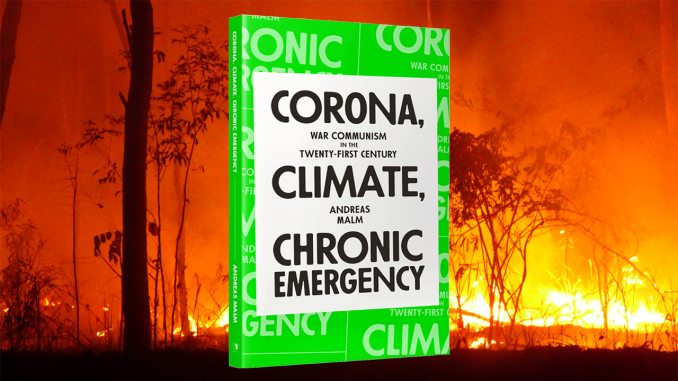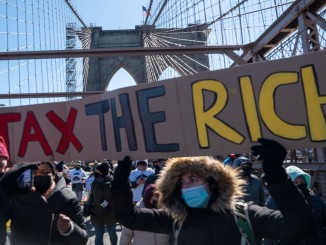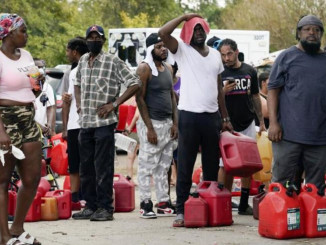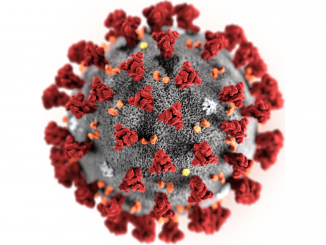
Andreas Malm’s recent book Corona, Climate, Chronic Emergency lays out the overlapping causes of both the global coronavirus crisis and impending ecological collapse. He intertwines these problems as stemming from the inherent nature of capitalism – a profit-driven system that destroys everything in its path for the sake of capital growth. Malm ensures the reader cannot finish the book without fully understanding the inextricable links between coronavirus and the climate crisis. They are in some ways one and the same crisis. Deforestation, the diversity-destroying practice used to generate profit by exploiting the land – primarily by producing “beef, soybean, palm oil and wood products,” in that order – is also stripping the earth of its protective mechanisms for sustaining life as we know it.
While they normally function as carbon sinks (absorbers of atmospheric carbon dioxide), forests can become carbon emitters when temperatures increase above a certain threshold. This positive feedback loop serves as a strong analogy for the logic of capitalism. The all-consuming drive for profit, with an exponential growth mindset that necessarily consumes land for increased commodity production, means that many natural processes that alleviate problems plaguing humanity have become, or will become, ineffective, or potentially even sources of crisis themselves. So, the only logical result of this madness is a world where temperatures continue to rise, and the forests that we once relied on to mitigate these increases, will be a part of the problem, too. Malm takes the implications of deforestation even further, connecting it to the inevitable decline in the health of the global human population.
Deforestation not only exacerbates the climate crisis, but opens up humanity to deadly viruses, such as coronavirus. Typically, the biodiversity of a forest means that viruses don’t travel far. The large variation in species acts as a reservoir or buffer between novel viral diseases and the humans that exist outside of these mainly large tropical habitats. Take away these natural buffers and disease will certainly spread. Add global travel and trade on a level never before seen in human history, and the only logical outcome is contagion threatening to bring about global pandemics. Malm makes clear that this condition cannot but be reinforced by capitalism, as “capital is fastened to ever more land and sucking its contents into circulation at an ever madder pace,” paving the way for a “high risk of zoonotic pandemics [pandemics caused by infections jumping from animals to humans].” Intensified animal agriculture further entangles human populations in zoonotic pathogen pools. As exploitation sharpens, squeezing more profit out of each worker and devastating biomes throughout the world, interactions between animal-borne diseases and human populations increase. This is inevitable with capitalism and, as long as it continues, we can only expect more global outbreaks – many of which could be far deadlier to humanity than the pandemic we’re dealing with now.
Malm does not believe the capitalist state can save us; it has shown it is incapable of taking the steps needed. In fact, the only reason it’s shown any semblance of a response to the COVID pandemic is that, unlike climate change, this has been a disaster with immediate implications that affect capitalists as well as the rest of us. Nor would COVID shutdowns be permanent measures, unlike the steps necessary for waging an appropriate response to climate change, which would have huge long-term impacts on systems of production, the capital invested, and the profits of the capitalist class.
Malm also correctly explains that, in the context of capitalism, the green technologies that exist today will merely commodify the greenhouse gases (generated primarily from the burning of ancient carbon – oil, gas, and coal) that must get captured, relegating these innovations to failure. After all, why would carbon capture companies choose to “negate the logic of the commodity,” tucking away carbon instead of selling it?
Additionally, Malm paints an accurate picture of the inadequacy of anarchist and social democratic means for remedying the inseparable problems of climate change and pandemics. He uses the analogy of a traffic light to express the irrationality of the “get the state off our backs” logic of anarchism. It’s clear that removing the “deadening hand” of the state from the streets (i.e., traffic lights) does not result in more “responsible driving and civic courtesy.” Likewise, having no state power means that we will be without effective tools to bring about the kind of transition required. Only state power will be able to exert the kind of authority that could put humanity on course for survival.
In fact, Malm extolls the need for an approach analogous to “war communism.” War communism refers to a period between June 1918 and March 1921 when the brand-new Soviet government instituted sweeping changes in Russia due to the onslaught of crises they faced: civil war supported by invasions from imperialist countries, famine, epidemics, the destruction of mass industries, and the absolute lack of access to fossil fuels to power industrial production. In order to address these crises, the Bolsheviks nationalized and centrally coordinated all industries, took state control of foreign trade, requisitioned agricultural surpluses and centrally distributed and rationed food, banned capitalist private property, and took military control of the railways. War communism was this temporary policy of emergency measures that were forced onto the Soviets by war and ruin, and were necessary to defend the workers’ revolution. Most importantly, and particularly in relation to our growing catastrophe today, war communism focused on attacking the causes, the drivers of the crisis rather than the effects or symptoms. And yet, despite the apparent ruthlessness of the Bolsheviks’ approach, their fundamental commitment to a better world was evident in their decision to preserve the ecology of “wild areas” in the midst of war communism.
Only a centralized apparatus has the power and oversight to direct productive energy in a conscious and organized manner on the scale required. The problem isn’t one of large-scale administrative bodies, but of the interests they represent – the exploitative interests of capitalism. We need a state that is run by and under the direct control of those it represents and works in the interests of humanity and the biosphere. The efforts of mutual aid groups to take on some of the roles the state should be doing, are far less efficient and inescapably inadequate, given the scale of the problems we confront. In pointing this out, Malm clarifies the infeasibility of mutual aid as a long-term solution as well.
Similarly, in an elegy for social democracy, Malm clearly explains why these politics are not a viable challenge to capitalism either. As he states, “When social democracy did have its days of glory, it was in the most tranquil societies modern history has known.” Perhaps when he wrote “tranquil,“ he meant in terms of a relative tranquility of domestic politics within the imperialist states; we can’t ignore the ravages of their colonialism and the wars the workers of those nations were sent into to defend the interests of their exploiters. And our own era is hardly tranquil. The reforms that social democracy has been able to grant in the past were in times of economic expansion and horrific exploitation of people under colonial domination (which most of those social democratic organizations accepted). Those gains were won when ecological collapse was not a pressing issue threatening the entirety of the species, and economic crisis was merely episodic. In other words, “Social democracy works on the assumption that time is on our side.” It bases its politics on the idea that reforms can be won slowly, through the democratic process within a fundamentally exploitative system. But time is gone. We can’t wait around for bourgeois politicians to come to the conclusion that they should act in the interests of humanity – the system they represent and defend is the problem. Even if it were possible to bring about reforms to end fossil fuel extraction or redesign the infrastructure of energy grids and transportation methods within capitalism (which it isn’t), the timelines for any of the multiple further climate catastrophes simply don’t allow us the time to incrementally enact such policies. We need to act now and act dramatically. As Malm says, the “time for gradualism is over.”
While clear on what won’t save us, he offers the reader a variety of technical solutions for what could be done if and only if we had the political will. He does lay out steps we could take to protect both the climate and human health, such as confiscating fossil fuel plants and turning them into carbon capture factories, disengaging the world from the “pathogen pools” of animal agriculture, and placing carbon capture technologies on every roof. Plus, Malm makes clear that steps to alleviate the greatest effects of the climate crisis also are relevant to reducing the global health burden. Prioritizing reforestation and leaving wildlife habitats alone not only protect the forests that serve as carbon sinks and conserves biodiversity, but act as primary prevention for the outbreak of future pandemics.
The expanse of Malm’s imagination should serve as great inspiration for those of us looking for answers on how we can meet the challenges of climate change. Malm shows us that the technical solutions are out there, and the creative drive to stop climate catastrophe is far from lacking. Imagine if we could quickly marshal the resources of society to preserve humanity and the rest of the biosphere. How many more ideas, like Malm’s, would we have in our arsenal for the battle against climate change?
Malm refreshingly does not claim to have all the answers. His openness to a variety of political solutions could be partially due to the fact that we don’t know the organizational forms that a movement against capitalism, and thus against climate change and future pandemics, will take. But what we do know, and what Malm does not commit to, is that the working class will necessarily have to be in the driver’s seat of any revolutionary movement if we want an enduring end to the destruction of our lives.
So more generally, in the how we get to the implementation of these solutions, Malm is less certain. And while claiming that “the capitalist state is constitutionally incapable of taking these steps,” he simultaneously contends that “there is no other form of state on offer.” While accurate in his assessment that there is currently no force strong or organized enough to contend with the capitalist state, he does not follow this sentiment by highlighting the need to cohere and mobilize such a force. Instead, he warns that “[w]aiting for [another state] would be both delusional and criminal, and so all we have to work with is the dreary bourgeois state, tethered to the circuits of capital as always.” And waiting to enact the changes we need would require bearing “popular pressure” upon the state, “shifting the balance of forces condensed in it, forcing apparatuses to cut the tethers and begin to move.”
But in reality, only a socialist workers’ state is capable of creating a consciously planned economy that benefits the planet and its inhabitants, ensuring a greater potential for the survival of the human species among others. Malm appears to put his confidence in a vaguer, movement-focused approach, with a declaration that it is criminal to wait for an upsurge of working-class strength given the time frame of the climate crisis.
It’s true – we’re running out of time. And this lack of focus on the productive class in capitalist society is a trend not without resonance in parts of the left. There is a recurring sentiment that, since there is no significant movement in the working-class, the climate emergency must be tackled by other means now, even if that entails appealing to the bourgeois state through immense popular pressure.
And we have seen in recent years a huge surge in social and political mass movements around the world, including the protests in the U.S. and elsewhere against racism and police violence. But are we relying upon these movements to bring about the fundamental shifts we need, or do we need to be more specific about how we can truly contend with the capitalist state? And is it delusional to focus our energies on building an organization and engaging in these struggles with the forces that will be needed to take state power, rather than fixating on methods for “shifting the balance of forces” within the capitalist state? If social democracy is a dead end, as Malm shows and we agree, promoting popular pressure upon the state as the solution is just an extension of that failed strategy. Of course, we must fight to impose our demands on the state for what is necessary for humanity and other life to thrive; but we must not rely on the capitalist state. Instead we must expose its integral role in the crises we face and the need for the working class to replace it with our own organizations. True, time is not on our side. But history has shown that only a revolutionary movement of the working class, organized in its own interests, is capable of overthrowing the bourgeois state in a conclusive and enduring way.
In our war against climate change, we will need workers in all industries to take ownership of the productive process, and redirect their energies towards preserving life – all organized through the structure of a state with the authority to allocate and coordinate resources according to necessity, as Malm describes in his discussion of war communism. But a movement that is not capable of imposing its own order by overturning the capitalist system, will not achieve the kinds of permanent changes we need to save ourselves.
While we see little revolutionary consciousness in the working class at this moment, we cannot abandon the only possibility to solve the problems we confront. History shows us that consciousness can change very quickly. In 1917 in Russia, the working class participated in protests against war and famine in February, but led a revolution to overthrow capitalism eight months later. A working-class revolution is needed, not because it’s the “ideal” solution, but because it’s the only solution that offers the potential for our survival. There are no short cuts or substitutions. The bourgeois states of the world won’t eliminate the deeply inlaid infrastructures of fossil capital, at least not in time. A lack of revolutionary consciousness in the working class does not mean we give up on the task, but rather it means we must more fully commit ourselves to the building of revolutionary working-class organizations that can play a leadership role in the movements of today. We must put forth our full confidence in the working people who have been making the society run in the interests of the capitalists because they’re the only ones who have the interest and capacity to make it run in the interests of us all.
In fact, tens of millions of people around the world, including millions of workers, have already shown determination in fighting to defend themselves against the deepening crises we face today. So, armed with Malm’s repugnantly beautiful and often poetic illustrations of how the climate crisis and coronavirus pandemic cannot but arise from the same exploitative system of capitalism, we’re up for the challenge of creating the international revolutionary workers’ organizations that we need to contend with capitalism and steer humanity away from its current course towards barbarism and even extinction.




